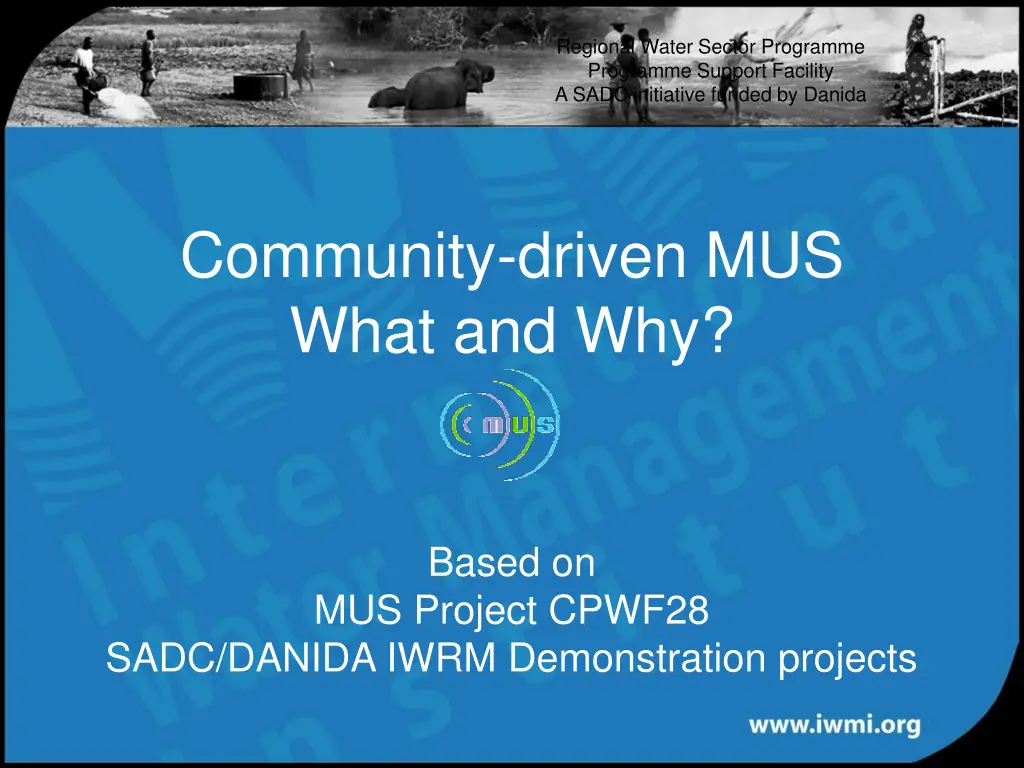
Community-Driven MUS for Water Sector Development
Explore the concept of Community-Driven Multiple-Use Systems (MUS) in the regional water sector. Learn about its benefits such as livelihood improvements, water resource efficiency, and resilient local institutions. Discover the phases and steps involved in implementing a community-driven MUS project, emphasizing participatory planning and monitoring.
Download Presentation

Please find below an Image/Link to download the presentation.
The content on the website is provided AS IS for your information and personal use only. It may not be sold, licensed, or shared on other websites without obtaining consent from the author. If you encounter any issues during the download, it is possible that the publisher has removed the file from their server.
You are allowed to download the files provided on this website for personal or commercial use, subject to the condition that they are used lawfully. All files are the property of their respective owners.
The content on the website is provided AS IS for your information and personal use only. It may not be sold, licensed, or shared on other websites without obtaining consent from the author.
E N D
Presentation Transcript
Regional Water Sector Programme Programme Support Facility A SADC initiative funded by Danida Community-driven MUS What and Why? Based on MUS Project CPWF28 SADC/DANIDA IWRM Demonstration projects
Community-driven MUS: Local government planning plus Responsible Organization Phases Steps Steps Creating a supportive environment Local authorities and support agencies Participatory planning, implementation and monitoring Step Three: Understand the community and build capacity Step Four: Create a vision and select activities to fulfil it Step Five: Compile action plans Implement- ation Step One: Mobilize support Continuous Step Seven: Do participatory monitoring and evaluation and impact assessment for follow-up Initial Step Two: Select communities Communities facilitated by local structures and support agencies Participatory planning Step Six: Implement the action plans
Why community-driven MUS? More livelihood benefits for own priorities, especially by the poorest and women (if targeted) More water resource and technological efficiency & resilience Stronger and more sustainable local institutions Local government planning plus : scalable nation- wide
1. More livelihood benefits for own priorities, especially by the poorest and women (if targeted) Including the marginalized from earliest planning onwards (e.g. in technology choice and site selection) Multiple uses for all MDGs Priority uses by gender, wealth& livelihood (priority for homestead-scale MUS?) Priority interventions in longer-term vision
2. More water resource - and technological efficiency and resilience taking all existing infrastructure as sunk costs tapping local technical knowledge integrating full water cycle: (re-) use & waste combining multiple sources for resilience considering full project cycle, incl. maintenance and rehabilitation economies of scale in infrastructure avoiding infrastructure damage of non-planned uses
3. Stronger and more sustainable local institutions building on century-old institutional capital for integrated water self-supply for multiple uses from multiple sources integrating new institutions ( water committees ) in one-window participatory processes
4. Local planning plus: scalable nationwide Local government s mandate: service delivery resource management accountability and transparency local knowledge and relationships cost-effectiveness sustainability
Next pilot testing/tool development for community-driven MUS, e.g.: integrated water resource&needs assessment reaching the marginalized participatory technical feasibility assessment and technology choice translation of options into bankable work plans community empowerment, transparency and accountability in financing streams integration in local planning and accountable relationships with service providers cost-benefits analysis support at intermediate and national level etceteras
